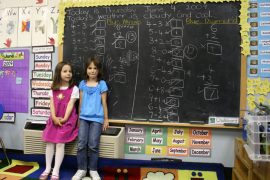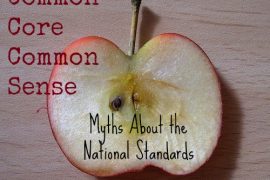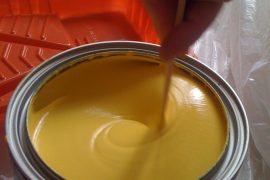I’m betting that many of you dear readers will identify with today’s guest post from Lisa Tabachnick Hotta. Math anxiety may still dog some of us, but it doesn’t have to ruin our lives. Read my guest post on her blog here.
“Miss Tabachnick,” exclaimed my grade 8 math teacher. “Please come up to the board and demonstrate how you obtained the answer to that equation; I’m sure the entire class will benefit from your explanation.”
Sweat trickled its way from my brow to my toes. Show the class? Now? At the chalk board? Somehow I must’ve squeaked out the answer because I did graduate – from grade 8, then from high school and ultimately obtained two university degrees. (My majors, of course, had absolutely nothing to do with math!)
Anxiety in all its sweaty glory – shaky hands, racing pulse, nausea – is pretty much the story of my life when it comes to math. Of course I’m rarely at a chalk (or smart) board deciphering mathematical problems these days as a writer, community volunteer and parent. But, you will often find me deep in “grownup” math conundrums. Here are but a few examples:
- Recently I was out for dinner with the girls and we were splitting the check. “Anne, you’re the accountant, you can figure out what we all owe,” I half-joked to one member of our group. She wasn’t amused. (Maybe it’s like the doctor who’s always getting asked for health tips at parties?) Her reluctance to assist me meant having to figure out not only what my drink, dinner and dessert cost but also my portion of the tax and tip – not at all easy for someone who’s math challenged!
- My son who is (miraculously) gifted in math, asked me fairly simple questions in the car as a kind of numbers game: What’s 2 + 2, What’s 4 + 4, What’s 8 + 8, What’s 16 + 16, etc. Now, the first few questions? No problemo. But, as the numbers and queries got larger, I had to think harder to come up with the answers and, yes, that in turn increased my anxiety level.
- Just today my kids and I were at a medical appointment. The administrator explained that receiving a response from the government to our query could take up to 30 weeks. I laughed along with the other adults who joked about government inefficiencies but, somewhere in my mind, I was still trying to figure out how many months equalled 30 weeks.
All joking aside, being mathematically challenged has caused me enormous stress. From hiring tutors throughout middle and high school, to being told (by that same grade 8 math teacher) that I’d never amount to anything because my math skills were so poor, to ensuring that I am charging clients appropriate rates on invoices – I’ll be forever haunted by issues around math.
So, how do I cope as a math-phobic adult? Luckily, I’ve learned to lean on my strengths – writing, communications and art. I also lean on calculators! Have you heard the expression, “fake it ‘til you make it”? I’ve also employed that strategy more than once. And, I’ve found that humor works well – I’ll just admit outright that math isn’t my forte and, while I’d be happy to volunteer as project manager or group leader, appointing me treasurer really isn’t the best idea.
Lisa Tabachnick Hotta is a professional writer, editor, social media expert and researcher who lives just north of Toronto, Ontario. Lisa specializes on topics related to health, mental health, family, the arts and society. Check out her blog: KidsAndMentalHealth.com.
What are your childhood memories of math anxiety? How does math anxiety influence your life now? How have you learned to get around it?











